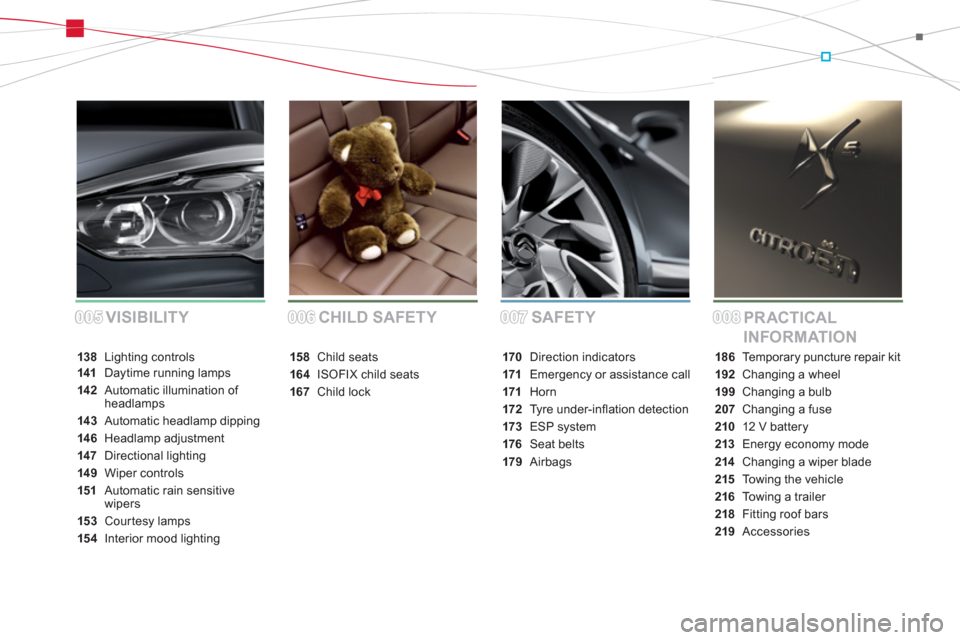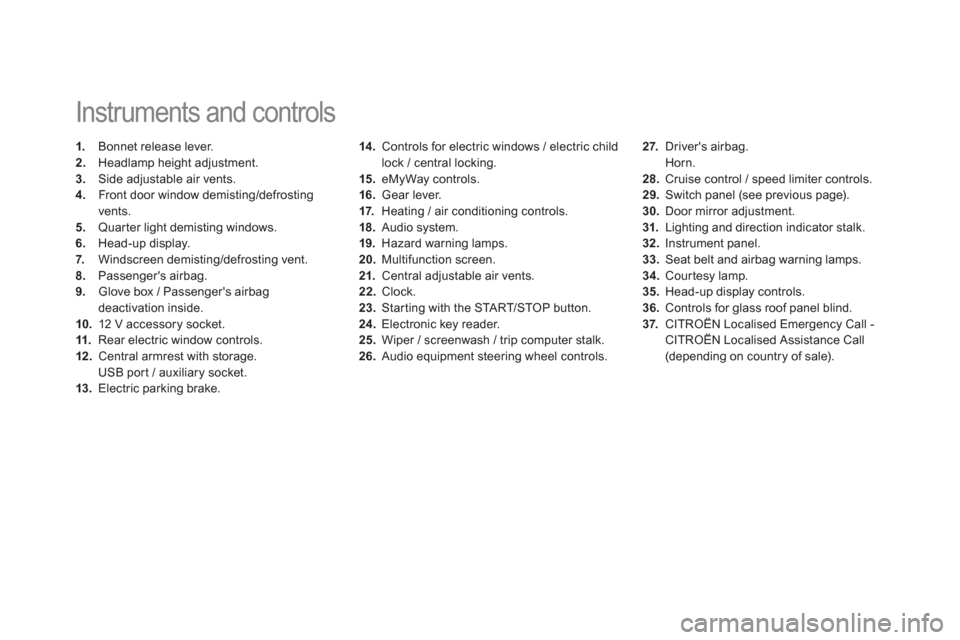roof Citroen DS5 2013 1.G Owner's Manual
[x] Cancel search | Manufacturer: CITROEN, Model Year: 2013, Model line: DS5, Model: Citroen DS5 2013 1.GPages: 356, PDF Size: 10.25 MB
Page 5 of 356

001001002002003003004004 COMFORT ACCESS MONITORINGDRIVING
Instrument panel
31 Indicator and warning lamps
40Gauges and indicators
44Adjustment buttons
46 Setting the date and time
46 Clock
48 Tr i p c o m p u ter
52 Electronic key - remote control
61 Boot
62 Alarm
64 Electric windows
66 Cockpit glass roof
68Fuel tank
69 Misfuel prevention (Diesel)
74 Front seats
79Rear seats
82Mirrors
83Steering wheel adjustment
84Interior fi ttings
88Boot fi ttings
89 Tr i a ngle (stowing)
90 Heating and Ventilation
92 Dual-zone digital air conditioning
96 Rear screen demist - defrost
100 Starting-switching off theengine103 Electric parking brake111Hill start assist112 Manual gearbox113Gear shiftindicator114 Automatic gearbox1186-speed electronic gearboxsystem122Stop & Start125 Lane departure warning system126 Head-up display129Speed limiter131 Cruise control133 Parking sensors135 Reversing camera
Page 6 of 356

005005006006007007008008SAFETY
PR ACTICAL
INFORMATION CHILD SAFETY VISIBILITY
138 Lighting controls141Daytime running lamps
142Automatic illumination of headlamps
143 Automatic headlamp dipping
146Headlamp adjustment
147 Directional lighting
149 Wiper controls
151 Automatic rain sensitive
wipers
153Courtesy lamps
154Interior mood lighting
158 Child seats
164ISOFIX child seats
167 Child lock
170 Direction indicators
171 Emergency or assistance call
171 Horn
172 Tyre under-infl ation detection
173 ESP system
176Seat belts
179Airbags
186Te m p o r a ry puncture repair kit
192Changing a wheel
199Changing a bulb
207 Changing a fuse
210 12 V battery
213 Energy economy mode
214Changing a wiper blade
215 Towing the vehicle
216Towing a trailer
218 Fitting roof bars
219 Accessories
Page 16 of 356

14 . Controls for electric windows / electric child lock / central locking.
15. eMyWay controls.
16.Gear lever.
17. Heating / air conditioning controls.
18
. Audio system.
19.Hazard warning lamps.
20.Multifunction screen.21. Central adjustable air vents. 22.Clock.
23.Star ting with the STA R T/STOP button.
24.Electronic key reader.
25. Wiper / screenwash / trip computer stalk.
26. Audio equipment steering wheel controls.
Instruments and controls
1.
Bonnet release lever.2.
Headlamp height adjustment. 3.
Side adjustable air vents.4.
Front door window demisting/defrosting
vents.
5. Quarter light demisting windows.
6.Head-up display.7. Windscreen demisting/defrosting vent.8.Passenger's airbag. 9.
Glove box / Passenger's airbag deactivation inside. 10.12 V accessory socket. 11.
Rear electric window controls.12.Central armrest with storage.
USB por t / auxiliary socket. 13.Electric parking brake.
27. Driver's airbag.
Horn. 28. Cruise control / speed limiter controls.29.
Switch panel (see previous page).30.
Door mirror adjustment.
31.Lighting and direction indicator stalk .32.
Instrument panel. 33.
Seat belt and airbag warning lamps. 34.Courtesy lamp. 35.Head-up display controls. 36.Controls for glass roof panel blind.37.CITROËNLocalised Emergency Call -
CITROËNLocalised Assistance Call(depending on country of sale).
Page 27 of 356

25
Familiarisation
Eco-driving
Eco-driving is a range of everyday practices that allow the motorist to optimise their fuel consumption and CO2 emissions.
Optimise the use of
your gearbox
With a manual gearbox, move off gently, change up without waiting and drive by changing up quite soon. If your vehicle has the system, the gear shift indicator invites youto change up; it is displayed in the instrumentpanel, follow its instructions.
With an automatic or electronic gearbox, stay in Drive "D"or Auto "A"
, according to the type of gearbox, without pressing theaccelerator pedal heavily or suddenly.
Drive smoothly
Maintain a safe distance between vehicles, use engine braking rather than the brake pedal, and press the accelerator progressively. These practices contribute towards a reduction in fuel consumption and CO2 emissions and also helps reduce the background traffic noise.
If your vehicle has cruise control, make use of the system at speeds above 25 mph (40 km/h) when the traffic is flowing well.
Control the use of your electrical equipment
Before moving off, if the passenger compartment is too warm, ventilate it byopening the windows and air vents before using the air conditioning.
Above 30 mph (50 km/h), close the windowsand leave the air vents open. Remember to make use of equipment that canhelp keep the temperature in the passenger compartment down (sunroof and window blinds...).Switch off the air conditioning, unless it has automatic digital regulation, as soon as the desired temperature is attained.Switch off the demisting and defrosting controls, if not automatic.Switch off the heated seat as soon as possible.
Switch off the headlamps and front foglamps when the level of light does not require their use.
Avoid running the engine before moving off,particularly in winter; your vehicle will warmup much faster while driving.
As a passenger, if you avoid connecting your multimedia devices (film, music, video game...), you will contribute towards limitingthe consumption of electrical energy, and soof fuel.
Disconnect your por table devices beforeleaving the vehicle.
Page 28 of 356

Limit the causes of excess
consumption
Spread loads throughout the vehicle; placethe heaviest items in the bottom of the boot,as close as possible to the rear seats.Limit the loads carried in the vehicle andreduce wind resistance (roof bars, roof rack, bicycle carrier, trailer...). Use a roof box in preference.Remove roof bars and roof racks after use.
At the end of winter, remove snow tyres and refit your summer tyres.
Observe the recommendations
on maintenance
Check the tyre pressures regularly, when cold, referring to the label in the door aper ture, driver's side. Carry out this check in par ticular:
- before a long journey,
- at each change of season,
- after a long period out of use.
Don't forget the spare wheel and the tyres onany trailer or caravan.
Have your vehicle ser viced regularly (engine oil, oil filter, air filter...) and obser ve the schedule of operations recommended by themanufacturer.
When refuelling, do not continue after the 3rd
cut-off of the nozzle to avoid any over flow.
At the wheel of your new vehicle, it is onlyafter the first 1 800 miles (3 000 kilometres) that you will see the fuel consumption settle down to a consistent average.
Page 68 of 356

Cockpit glass roof
A tinted glass panoramic sur face to increase
the light and visibility in the passenger compartment. Fitted with three electric blinds to improve
tem
perature and noise related comfort. There are two options for openin
g and closing:
Electric blinds
�)Pull or press control, going beyond the point of resistance.
One press opens or closes the blind
completely.
After a new action on the the control, the
blind continues moving for around 2 cm,
then stops.
�) Pull or press the control without going
beyond the point of resistance (forwards to close and rear wards to open).
When you release the control, the blindcontinues moving for around 2 cm, thenstops.
Page 156 of 356

Interior mood lighting The dimmed passenger compar tment lighting improves visibility in the vehicle when the light is poor.
At night, the interior mood lighting comes onautomatically when the sidelamps are switched
on (for example, a source of light in the roof console illuminates the middle of the centre console).
The interior mood lighting switches off automatically when the sidelamps are switched off. Lamps on: there are 7 levels o
f brightness.
The level of brightness increases progressively
with each press of the button, returning to zero after the maximum level is reached.
A long press gives maximum brightness.
This adjustment is used to set the mood lighting level for the interior lamp, as well as for the door opening controls and the storage locations
(depending on version).
Foot well lighting
Activation
Its operation is identical to that of the cour tesy
lamps. The lighting comes on when one of the
doors is opened. The soft li
ghting provided by the footwell lamps
improves visibility in the vehicle when the light
is poor.
Switching on
Adjusting the brightness
of the courtesy lamp
Page 184 of 356

Sit in a normal upright position.
Wear a correctly adjusted seat belt.
Do not leave anything between theoccupants and the airbags (a child, pet,
object...). This could hamper the operation of the airbags or injure the occupants. After an accident or if the vehicle has beenstolen or broken into, have the airbagsystems checked. All work on the airbag system must be carried out by a CITROËN dealer or a qualified workshop.
Even if all of the precautions mentioned are obser ved, a risk of injury or of minor burns to the head, chest or arms when an airbag is deployed cannot be ruled out. Thebag inflates almost instantly (within a few milliseconds) then deflates within the sametime discharging the hot gas via openings provided for this purpose.
Lateral airbags
Use only approved covers on the seats, compatible with the deployment the lateral airbags. For information on the range of seatcovers suitable for your vehicle, you can contact a CITROËN dealer, Refer to the "Accessories" section.Do not fix or attach anything to the seat backs (clothing...). This could cause injuryto the chest or arms if the lateral airbag isdeployed.Do not sit with the upper par t of the body anynearer to the door than necessary.
Front airbags
Do not drive holding the steering wheel by its spokes or resting your hands on the centre part of the wheel.
Passengers must not place their feet on thedashboard.
If possible, do not smoke as deployment of the airbags can cause burns or the risk of injury from a cigarette or pipe.
Never remove or pierce the steering wheel or hit it violently.
For the airbags to be fully effective, observe the following safety rules:
Curtain airbags
Do not fix or attach anything to the roof. Thiscould cause injury to the head if the cur tainairbag is deployed.
If fitted on your vehicle, do not remove the grab handles installed on the roof, they playa par t in securing the cur tain airbags.
Page 220 of 356

Fitting roof bars
rack, for a loading height not exceeding40 cm (with the exception of bicycle carriers): 70kg.
If the height exceeds 40 cm, adapt the
speed of the vehicle to the profile of theroad to avoid damaging the roof bars and the fixings on the roof.
Be sure to refer to national legislation in order to comply with the regulations for transporting objects which are longer than the vehicle. When
fitting transverse roof bars, take care toposition them correctly: Use accessories recommended by CITROËN obser ving the manufacturer'srecommendations and fitting instructions so as to avoid the risk of damaging the body (deformation,scratches, ...).
�)Remove the cap using an allenTM key. �)Put the bars into position then fit and
tighten the securing screws.
Page 221 of 356

219Practical information
Accessories
A wide range of accessories and genuine par ts is available from the CITROËN dealer network.
These accessories and par ts have been tested and approved for reliability and safety.
They are all adapted to your vehicle and benefit from CITROËN's recommendation and warranty.
"Comfort":
door deflectors, side window blinds, rear screen blind, isotherm module, coat hanger fixed to head restraint, mobile reading lamp, mirror for caravan, parking sensors...
"Transport systems":
child seats and booster cushions, boot carpet,
boot liner, boot net, boot spacers, transverse
roof bars, bic
ycle carrier, ski carrier, roof boxes,
towbars, wiring harnesses...
If a towbar and wiring harness are fitted
outside the CITROËN dealer network, theinstallation must be done using the vehicle's electrical pre-equipment and fitted following the manufacturer's recommendations.
"Styling":
gear lever knobs, aluminium foot rest, alloy wheels, chrome mirror shells, chrome door aperture finishers...
*
To avoid an
y risk of jamming the pedals:
- ensure that mats are correctly positionedand secured,
- never fit one mat on top of another.
"Security and safety":
anti-intrusion alarm, anti-tilt unit, stolen
vehicle tracking system, child seats and
booster cushions, breathalyser, first aid kit, fire
extinguisher, warning triangle, high visibility
vest, wheel security bolts, snow chains, non-
slip covers...
"Protection":
mats * , seat covers compatible with lateral
airbags, mud flaps, door protective mouldings,bumper protection strips, vehicle cover...
The rear bodywork has been designedto avoid spray.